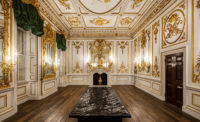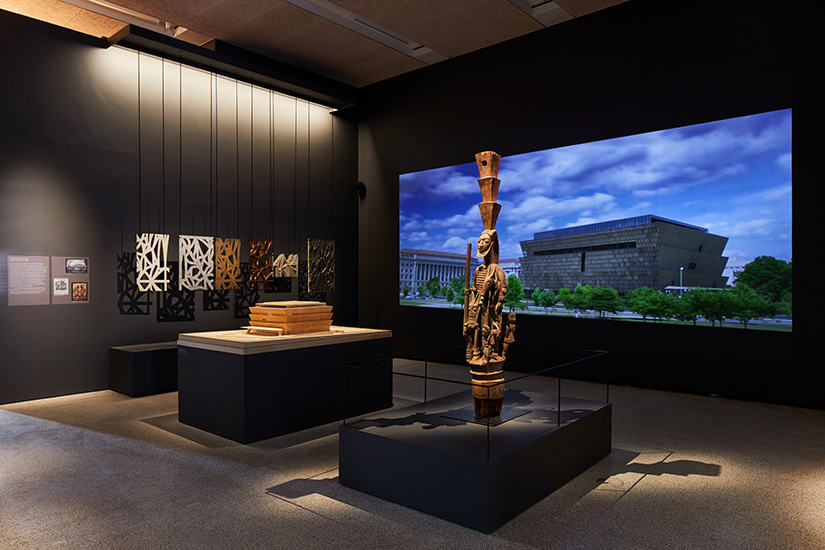David Adjaye’s ‘Making Memory’ at the Design Museum Explores Monuments and Memorials

David Adjaye: Making Memory at the National Design Museum
Photo and model of the National Museum of African American History and Culture
Photo © Ed Reeve

Fragment of the Sclera Pavilion replicated using American tulipwood.
Photo © Ed Reeve

Sclera Pavilion replicated using American tulipwood
Photo © Ed Reeve

Model of the Smithsonian National Museum of African American History and Culture
Photo © Ed Reeve

Model of the Smithsonian National Museum of African American History and Culture in front of a series of prototype facade panels
Photo © Ed Reeve

A series of prototype facade panels used in the development for the design of the Smithsonian National Museum of African American History and Culture
Photo © Ed Reeve

Close up of Gwangju River Reading Room Pavilion model
Photo © Ed Reeve

Model of the National Cathedral of Ghana
Photo © Ed Reeve

Model of the National Cathedral of Ghana
Photo © Ed Reeve

A series of Asante umbrellas that influenced the design of the National Cathedral of Ghana
Photo © Ed Reeve

Replica of part of the UK Holocaust Memorial and Learning Centre
Photo © Ed Reeve











Architects & Firms
David Adjaye’s Making Memory is the architect’s second major exhibition at London’s Design Museum. The first was almost a decade ago—shortly after he landed the career-defining commission to build the Smithsonian National Museum of African American History and Culture in Washington DC—and Urban Africa (2010) showed the fruits of his self-initiated mission to photograph every African capital city. The current show, presenting seven of Adjaye’s projects as a means to explore the role of contemporary monuments and memorials, is bigger and materially richer, but was born of the same concerns.
Adjaye chose to study Africa to uncover the ways that power has buried knowledge of other cultures, with a resultant loss of visibility and esteem. “I deeply desire a world in which knowledge is above power,” he says. Now, as an architect with major public commissions, dealing with sensitive sites and subjects, he questions the use of architectural objects to shape or articulate collective memory. Conventional obelisks and triumphal arches—such as those depicted at the start of the exhibition—belong to an age in which official history was not to be questioned, values were assumed to be universal, and memorials demanded a prescribed, ritualized form of observance from visitors. How might monuments be “democratized” for a more egalitarian age, in which a greater plurality of voices expects to be heard, and “a new generation re-evaluates the legacy of colonial and other histories,” asks the architect?

Imparting and exchanging knowledge is the common feature of almost all of the projects on display, of which four are structures primarily intended as memorials, and two—the Smithsonian and the National Cathedral of Ghana in Accra—have an explicit role as emblems of shared identity. (Adjaye makes something of a stretch in calling the seventh project, a timber pavilion constructed for a London design festival, a “monument to slowed time”).
Allowing the public to examine original source material is common to three purpose-made sites of remembrance for traumatic events in recent history. The blackened timber and concrete Gwangju River Reading Room (2013), which commemorates the 1980 massacre of South Korean student democracy protestors, houses a library of 200 books on freedom and human rights. A proposed Holocaust memorial for a prominent site next to London’s Houses of Parliament sits above a subterranean exhibition and learning center. And at a memorial to Coretta Scott King and Martin Luther King Jr. on Boston Common—currently among five design competition finalists—visitors will be able to access biographical information via their phones, as well as reading transcripts of speeches etched into the walls. Another as-yet unbuilt project, MEMO, is a “live” memorial to extinct species, situated on the Jurassic Coast of Dorset, southwest England. One hundred feet high and constructed of local stone, the spiraling ziggurat will contain a long walkway that wraps around a central cavity in which a bell tolls each time a species becomes extinct.
Another of Adjaye’s approaches to memorial architecture is event in both the Washington and Accra projects. While the Smithsonian had to contend with the history of slavery, Adjaye was also concerned that it should reflect African-Americans’ transcendence of that legacy, and also offer a speculative vision of what the African experience in America might have been had history been different, with greater prestige and visibility afforded to rich and complex cultures. Likewise, the Accra cathedral is deeply influenced by objects with sacred value in Ghana—including carved stamps, stools and large colored umbrellas that are presented as exhibits in the show—but is offered to the country as a vision for how it might develop, unique to itself.
The Design Museum’s director, Deyan Sudjic, describes staging the exhibition as an invitation to the architect to “think in public,” and Adjaye couches his response as a “provocation” to visitors. His analyses are not offered as a manifesto, but as an invitation to reflect. Stepping out from the museum entrance, the visitor is back in a city densely overlayed with memorial markings. Immediately to the left, a plaque commemorates the 1805 defeat of Napoleon at the Battle of Trafalgar. To the right, another records an 1882 visit by Cetshwayo, King of the Zulus. Primed by the exhibition, one notices them afresh. “Whenever I make a show I’m trying to get people to be more conscious of things they take for granted,” says Adjaye. “What does it mean to memorialize things in our society and how does built form contribute. I’m showing my response in the projects, but also asking, ‘What do you think?’”














